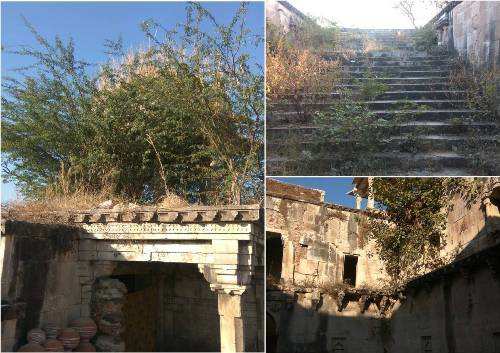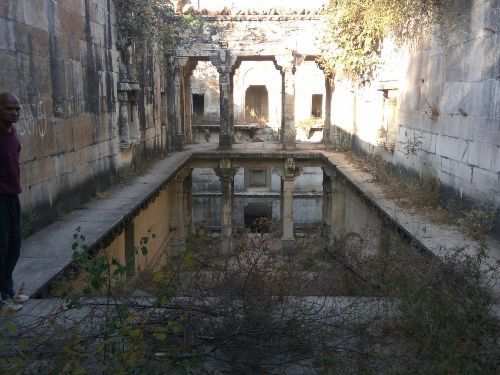Stepwell in Mavli, a neglected testimony of the Medieval Era
Stepwells, in earlier days were a source of drinking water and water reservoirs for irrigation till centuries. A Stepwell is commonly known as Baori or Bavdi too. Step Wells are generally found in the arid zone of India but they were plenty in the princely state of Mewar
Stepwells, in earlier days were a source of drinking water and water reservoirs for irrigation till centuries. A Stepwell is commonly known as Baori or Bavdi too. Step Wells are generally found in the arid zone of India but they were plenty in the princely state of Mewar.
This year it so happened that the annual calendar published by Maharana Mewar Historical Publications Trust is dedicated to step wells. On seeing the calendar, it reminded me of a stepwell located in my village Mavli. The said stepwell is known as Baijiraj Ki Baori.
From my childhood, I have witnessed that it is deserted and not used for drinking water or irrigation either. The abandoned Baijiraj Ki Baori is at the mercy of Department of Devasthan, Rajasthan. The stepwell is surrounded with a garden and the garden is known as Aamlia Bagh. For years it has been a place for male defecation for locals. With the improvement in life style, the bagh is now not being used for defecation.

The entire bagh and baori is a deserted place, with the wall of the garden eroding over a period of time and its main entry gate having collapsed years ago.
The marble made baori is in ruins now and at many places marble stones have been removed for personal use. In my childhood, the place (Baori and Aamlia Bagh) used to have such a deserted look that none would enter into the area after sunset as it was considered to be haunted.
The locals were unaware of the history of this Baori, except that it was given to a princess of royal family of Udaipur state in dowry. In my efforts to unearth its history, I found one reference from the memories of Colonel James Tod, who visited Mavli in 1820.
He wrote “Maowlee, 26th Oct; seven and half miles .- As usual, all was barren between Sunwar1 and Maowlee; though at each are the traces of reviving industry. This was formerly a considerable town, and rated in books at seven thousand rupees annual rent; but now it yields not seven hundred. Its population consists of about eighty families of all classes, half of which have been recalled from their long exile in Malwa and Candiesh2, and have already given a new aspect to Maowlee in its sugarcanes. Her highness’ steward, however, is not one of the faithful. There is a very fine bawari, or reservoir, of coarse marble, constructed by Bae Raj, ‘the royal mother’, of the present Rana and his sister, it whose appendage it is.”
1 Present day Sanwar (Fatehnagar) 2 Khandesh (Jalgaon, Burhanpur belt of Maharashtra & MP).
As history suggests, Royal family of Udaipur signed a treaty with British in January 1818. The treaty became inevitable because of Maratha intervention where Holkars and Scindia taxed Rajputana rulers and looted public at their freewill. For ninety long years there was anarchy due to Maratha intervention in the affairs of Rajputana, in which Mewar was no exception. Many citizens of Mewar fled to Malwa and Khandesh in quest of a better life. To overcome the Maratha atrocity, the then Rana of Mewar, Bhim Singh, who averted the looting of Shreenathji temple by offering personal ornaments of Maharani to Scindia decided to sign a treaty with British. On signing the treaty with the British in 1818, Colonel James Tod became the first British regent appointed in Mewar. His version on Mavli and other factors helped in arriving at the conclusion that :
- The village had only eighty houses in 1820 of various caste;
- Half of them have returned from Malwa and Khandesh (Jalgaon belt) to Mewar after British treaty;
- Baijiraj Bawri was built by mother and sister of the then Rana Bhim Singhji. As per history, the mother of Maharana was Rajmata Sardar Kunwar Jhali. She was from Gogunda Jhala family and married to Maharana Ari Singhji-II. Maharana Ari Singh-II had only one daughter named Baisa Chandrawatiji married to Maharaja Parbat Singh of Ratlam.
Thus, it can be concluded that Baijiraj Bawri of Mavli was constructed between 1762 to 1772 during the reign of Maharana Ari Singhji-II. This makes the Baori nearly 250 years old.

Besides being a source of water, the bawri is also a fine architectural monument. For centuries, such stepwells in hilly and semi hilly terrain of Mewar were used for drinking water, bathing and irrigation. The Bawri normally has a cylindrical well that extends deep below the water level, with steps leading into the depths. Bawri also used to serve the needs of pilgrims and other travelers during their voyage, especially in summer. The Stepwell of Mavli is made of marble and has fine steps leading from the mounted ground level down to the water level. Alas, for years now the bawri has no water. Only during the monsoon, when rain is plenty and nearby located Hemsagar is full of water, the bawri will have water in it but no takers.

The rainy season bushes have since dried up all around the bawri including mounted plinth and stairs leading down to the water leval. It now looks ugly and is totally ruined. Locals have nothing to do with its upkeep, thus allowing it to ruin. Bushes around the mounted plinth of bawri have camouflaged its real look and a visitor has to be cautious while entering the bawri. In a state oriented drive, some 12 years ago, the Bawri was cleaned by a team headed by District Collector. However, one such effort had done no justice to it and things remain as usual.

Incidently, the Aamlia Bagh compound is also housing some Chatries (Cenotaphs), but their history is not known. About eighty years ago, the underneath base of one of the cenotaph was being used as Ramdwara by Ramsnehi saints. These cenotaphs are in total shambles and within two decade or so they would disappear for want of repair and conservation. One such Cenotaph at present is being used by one local pot maker to house his clay pots.
Development and modern substitutes like pipeline water supply have eliminated the need of fetching potable water from sources like bawri. They have been rendered useless and even if a stepwell has water, the stagnant water often becomes contaminated with garbage dump and other impurities.

Bairajji ki Bawri is the only historical monument of Mavli. It has been ignored by locals and government both. It would vanish slowly but definitely. This is the time to rise to the occasion and preserve our past classic structures like this Bawri.
It is learnt that the State Devasthan Department had recently mooted a proposal for repair and preservation of this Bawri and a fund of Rs. 1 Crore was demanded. Unfortunately, the State Govt did not allot the required funds. Hope the locals would take up the matter seriously and preserve this fine bawri.
हजारों साल नरगिस अपनी बेनूरी पर रोती है,
बडे कम होते है चमन में दीदावर पैदा
To join us on Facebook Click Here and Subscribe to UdaipurTimes Broadcast channels on GoogleNews | Telegram | Signal



